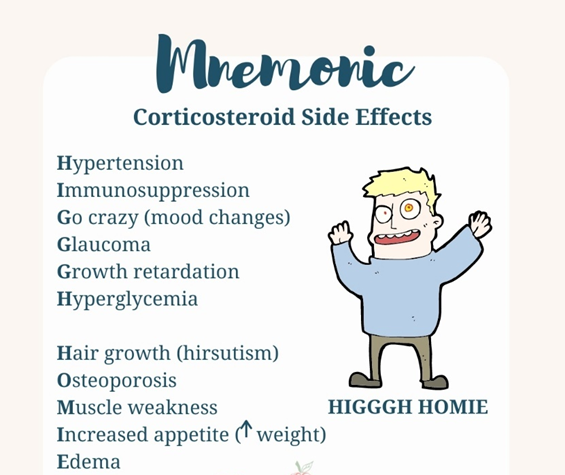A nurse is planning care for a client who has multiple sclerosis and is receiving methylprednisolone. Which of the following adverse effects should the nurse anticipate? (Select all that apply.)
Bladder spasms
Hypotension
Delayed wound healing
Hirsutism
Hyperglycemia
Correct Answer : C,D,E
Choice A Reason:
Bladder spasms are not commonly reported as adverse effects of methylprednisolone. However, bladder dysfunction can occur in individuals with multiple sclerosis due to the disease process itself, but it is not specifically related to corticosteroid therapy.
Choice B Reason:
Hypotension is not a common adverse effect of methylprednisolone. In fact, corticosteroids can often lead to fluid retention and sodium retention, which can contribute to hypertension rather than hypotension.
Choice C Reason:
Delayed wound healing is correct. Corticosteroids can impair the body's ability to heal wounds by suppressing the inflammatory response and collagen synthesis. Therefore, clients receiving methylprednisolone may experience delayed wound healing, which can be problematic, especially in individuals with pre-existing wounds or undergoing surgical procedures.
Choice D Reason:
Hirsutism (excessive hair growth, especially in women) can occur with long-term corticosteroid use due to the effect of steroids on hair follicles. It is a possible adverse effect of methylprednisolone.
Choice E Reason:
Hyperglycemia is correct. Corticosteroids can increase blood glucose levels by promoting gluconeogenesis, reducing glucose uptake by tissues, and inducing insulin resistance. Clients receiving methylprednisolone may develop hyperglycemia, which can be particularly concerning for individuals with diabetes or those at risk of developing diabetes.

Nursing Test Bank
Naxlex Comprehensive Predictor Exams
Related Questions
Correct Answer is D
Explanation
Choice A Reason:
Dyspnea is not commonly seen in other chronic conditions of the aging older adult: This statement is incorrect. Dyspnea, or difficulty breathing, can occur in various chronic conditions commonly seen in aging adults, such as chronic obstructive pulmonary disease (COPD), heart failure, and pulmonary fibrosis, among others. Dyspnea can be a symptom of respiratory or cardiovascular issues and is not exclusive to asthma.
Choice B Reason:
Aging is associated with decreased sensitivity to medications: This statement is generally incorrect. Aging can affect drug metabolism and clearance, leading to changes in medication sensitivity. Older adults may have altered pharmacokinetics and pharmacodynamics, which can increase their sensitivity to certain medications, particularly those with sedative or CNS depressant effects. This increased sensitivity can potentially increase the risk of adverse drug reactions.
Choice C Reason:
Adverse reactions to medications in the aging older adult are lower: This statement is incorrect. While some physiological changes associated with aging may decrease the risk of adverse drug reactions, such as decreased renal function and altered drug metabolism, older adults are still at risk for adverse drug reactions due to factors such as polypharmacy, drug interactions, and increased sensitivity to medications.
Choice D Reason:
Physiological changes in the respiratory system can mimic the presence of airway obstruction: This statement is true. Physiological changes in the aging respiratory system, such as decreased lung elasticity, increased chest wall stiffness, and reduced respiratory muscle strength, can mimic the symptoms of airway obstruction seen in conditions like asthma or COPD. These changes can lead to decreased lung function, reduced exercise tolerance, and increased susceptibility to respiratory infections.
Correct Answer is ["A","D","E"]
Explanation
Choice A Reason:
The client admitted with diabetic ketoacidosis (DKA) is correct. Diabetes is a common cause of peripheral neuropathy, particularly if poorly controlled. Diabetic ketoacidosis (DKA) is a severe complication of diabetes characterized by high blood sugar levels and ketone accumulation. Prolonged uncontrolled diabetes can lead to nerve damage and peripheral neuropathy.
Choice B Reason:
The client admitted with sleep apnea is incorrect. Sleep apnea is a sleep disorder characterized by pauses in breathing or shallow breathing during sleep. While sleep apnea itself is not typically associated with peripheral neuropathy, underlying conditions such as obesity or diabetes, which are risk factors for sleep apnea, can also increase the risk of peripheral neuropathy.
Choice C Reason:
The client admitted with a hypertensive crisis is incorrect. Hypertension (high blood pressure) is not directly associated with peripheral neuropathy. However, poorly controlled hypertension can lead to vascular complications and contribute to conditions such as atherosclerosis, which may indirectly increase the risk of peripheral neuropathy.
Choice D Reason:
The client admitted for an exacerbation of Systemic Lupus Erythematosus (SLE) is correct. Systemic Lupus Erythematosus (SLE) is an autoimmune disease that can affect various organs and tissues, including the peripheral nerves. Peripheral neuropathy can occur as a complication of SLE, particularly in cases of active disease or as a result of certain medications used to treat SLE.
Choice E Reason:
The client admitted with untreated tuberculosis is incorrect. Tuberculosis (TB) is a bacterial infection caused by Mycobacterium tuberculosis. While TB itself is not typically associated with peripheral neuropathy, certain medications used to treat TB, such as isoniazid, can cause peripheral neuropathy as a side effect.
Choice F Reason:
The client admitted with cirrhosis secondary to chronic alcohol use is correct. Chronic alcohol use and cirrhosis can lead to various neurological complications, including peripheral neuropathy. Alcohol-related peripheral neuropathy often presents with sensory symptoms such as tingling, numbness, and pain in the extremities.
Whether you are a student looking to ace your exams or a practicing nurse seeking to enhance your expertise , our nursing education contents will empower you with the confidence and competence to make a difference in the lives of patients and become a respected leader in the healthcare field.
Visit Naxlex, invest in your future and unlock endless possibilities with our unparalleled nursing education contents today
Report Wrong Answer on the Current Question
Do you disagree with the answer? If yes, what is your expected answer? Explain.
Kindly be descriptive with the issue you are facing.
